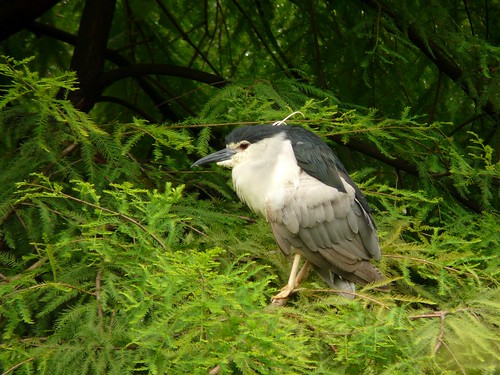Not that I didn't had anything to write about yesterday, but I forgot to put the battery inside my camera again, so no pictures were taken. Thankfully, the weather was rainy so I didn't miss out on anything. The usual monsoon months in Taiwan are April and May, but it seems to be delayed this year so expect wetter days from now on.
Today the weather got better - giving me a chance to take pictures of this handsome Black-crowned Night Heron (Nycticorax nycticorax).
Today the weather got better - giving me a chance to take pictures of this handsome Black-crowned Night Heron (Nycticorax nycticorax).

Now, to report a sad news - the three barbet fledglings inside this nest site below had disappeared! The last time we saw the offspring (for sure) was two days ago. Yesterday afternoon, we checked again and we initially saw nothing, but we were hesitant to make a conclusion. Before we could get another look, the webcam screen displayer ran out of battery, so we decided to call it a day since it was raining steadily by then. This morning, we had our observation equipments set up at this site. Before observing, we took another look. No birds (or bodies) inside the nest at all!!! After speaking to photographers that like to photograph these birds everyday, we came to the conclusion that something happened the night before. But what? Some speculate that the birds could be eaten by the stray cats or wild squirrels residing in the area. But we are leaning towards bird catchers that sell birds as pets, especially in Taipei's "Bird Alley", since the cavity hole is pretty smaller and the tree is pretty high up. Sigh, we will never know.
It is such a sad news since the fledglings are only a few days old and the chance of surviving without parental care is not very high. We, as researchers, hate to see these kinds of things happening since we need as much information as we can learn about these birds, especially since this is a nest constructed inside a living tree (which is very rare). And the same goes for the volunteers observing the birds for us because they have come to see the birds as part of their family insde the botanical garden. Furthermore, the photographers that come to document the everyday happenings of this little family are also shocked and disgusted.
It is such a sad news since the fledglings are only a few days old and the chance of surviving without parental care is not very high. We, as researchers, hate to see these kinds of things happening since we need as much information as we can learn about these birds, especially since this is a nest constructed inside a living tree (which is very rare). And the same goes for the volunteers observing the birds for us because they have come to see the birds as part of their family insde the botanical garden. Furthermore, the photographers that come to document the everyday happenings of this little family are also shocked and disgusted.
 But hopefully, the adult birds will return to this site to nest again soon.
But hopefully, the adult birds will return to this site to nest again soon.And learning this terrible news, we decided to move onto anther tree that needs observing.
 Sadly, we had not learned how to tell the gender in this pair, so we could only call them Birds A and B.
Sadly, we had not learned how to tell the gender in this pair, so we could only call them Birds A and B.
 Sadly, we had not learned how to tell the gender in this pair, so we could only call them Birds A and B.
Sadly, we had not learned how to tell the gender in this pair, so we could only call them Birds A and B. Bird A.
Bird A.
Bird A again??
In another nest site, we had shockingly learned that three eggs had been laid. But when? Because knowing the date of the first egg laid will help us predict the date of the egg hatch. Sadly, we did not know. So, in the afternoon, we set up a recording camera right outside the nest to bring us up-to-date on the status of this particular site.
To show you what Muller's Barbet's nest looks like, here are some photographs of an unused and naturally broken nest. As you can see, the entrance hole is about 5-cm, and bends downwards and enlarges into a chamber (that is about the size of your fist only). The bill marks at the bottom of the chamber indicate that this is a used nesting cavity (since cavity-nesting species like to make many cavities before selecting only one for the actual nest site).
To show you what Muller's Barbet's nest looks like, here are some photographs of an unused and naturally broken nest. As you can see, the entrance hole is about 5-cm, and bends downwards and enlarges into a chamber (that is about the size of your fist only). The bill marks at the bottom of the chamber indicate that this is a used nesting cavity (since cavity-nesting species like to make many cavities before selecting only one for the actual nest site).

No comments:
Post a Comment